IR IRS27951 240W AC-DC电源解决方案
发布时间:2011-12-6 21:01
发布者:Liming
|
IR公司的IRS27951/2是自振荡半桥驱动器,特别适用于LLC谐振DC/DC转换器应用.器件提供过流保护,每路工作频率最高为500kHz,可编程软起动时间和频率以及死区时间,主要应用在LCD & PDP TV,电讯和PC开关电源,家庭音频系统.本文介绍了IRS27951/2主要特性, 方框图, 典型应用电路图以及IRS27951评估板主要特性,电路图,材料清单和PCB布局图. The IRS2795(1,2) is a self oscillating half-bridge driver IC for DC-DC resonant converter applications, especially the LLC resonant half-bridge converter. The frequency and dead time can be programmed externally using two external components. The IC offers over current protection using the on state resistance of the low-side MOSFET. The IC can be disabled by externally pulling the voltage at the CT/SD pin below its enable voltage threshold. IRS27951/2主要特性: Simple primary-side control solution for fixed and variable frequency DC-DC resonant converters. Max 500kHz per channel output with 50% duty cycle Floating channel bootstrap operation up to +600Vdc programmable minimum and maximum switching frequency programmable soft start frequency and soft start time programmable dead time Micropower start-up & ultra low quiescent current Over-current protection using low side MOSFET Rds(on) User initiated micropower “Sleep mode” Under-voltage Lockout Simple design with minimal component count. Lead-free IRS27951/2应用: LCD & PDP TV Telecom SMPS, PC SMPS Home Audio Systems 
图1.IRS27951/2方框图 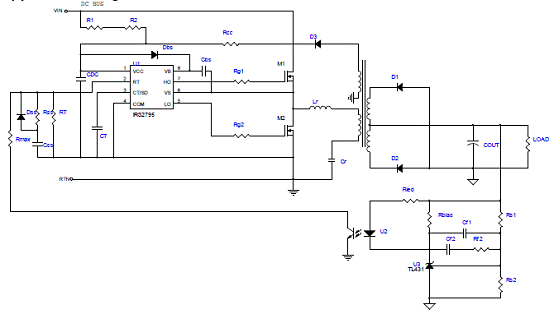
图2.IRS27951/2典型应用电路图 IRS27951评估板 This document details the test procedure for validation of IRAC27951SR-240W Evaluation Board, featuring the IRS27951 Resonant Half Bridge controller and the IR11682 dual-channel synchronous rectification controller. The document includes schematic diagram, test setup, test procedure, and test results. The evaluation board consists of a front-end AC-DC rectifier stage cascaded with a half-bridge resonant DCDC converter with 24V output voltage rail. The front end is a conventional rectifier stage with a rectifier bridge and an EMI filter. The downstream converter is a multi-resonant half bridge LLC converter whose control is implemented with the IRS27951 (U1) controller HVIC. The controller drives the two half-bridge MOSFETs with a 50 percent fixed duty cycle with dead-time, changing the frequency according to the feedback signal in order to regulate the output voltage against load and input voltage variations. As described earlier, in addition to current protection,all the critical functions needed to control resonant converter designs can be externally programmed using this 8 pin controller IC. IRS27951 is self-supplied in this reference design. The startup resistors Rstart1~Rstart3 provide startup current to IRS27951 during power up and charge the Vcc capacitors (CDC2 and CVcc1). Once Vcc voltage exceeds Vccuv+ threshold, IRS27951 starts operation and the auxiliary winding of power transformer can provide bias to the IC. The voltage of auxiliary winding could vary a lot when 24V load changes from 0A to 10A, so a linear regulator – Dz4, Rvcc and Q2 – is used to keep Vcc regulated at 14.5V. The transformer uses the magnetic integration approach, incorporating the resonant series and shunt inductances in the power transformer. The transformer configuration chosen for the secondary winding is center-tap. The feedback loop is implemented by means of a classical configuration using a TL431 (U3) to adjust the current in the optocoupler TLP621 (U2). The optocoupler transistor modulates the current from the RT pin of the controller IC to modulate the switching frequency, thus achieving output voltage regulation. The secondary rectification is implemented with synchronous rectification controller IR11682 and two PQFN power MOSFETs. Each leg of the output uses one IRFH5006, a 60V MOSFET with 3.5mohm on state resistance (typical). The conduction power loss is greatly reduced by using synchronous rectification. No heatshink is required for 10A continuous output current. PCB area is also saved with the highly integrated dualchannel SmartRectifierTM controller IR11682. The synchronous rectification circuit is connected in a low-side configuration. So IR11682 can directly drive the two SR MOSFETs. A RCD circuit is added to IR11682 VD sensing input to provide leading edge filter and turnoff delay compensation. IR11682 is biased by 24V output through a simple linear voltage regulator Q1 (a general NPN transistor) and zener Dz2 (12V). In addition, a second zener diode Dz3 (9.1V) is used to prevent the synchronous rectifier circuit be activated when output voltage is still low. The IR11682 will start operation when output voltage is approaching 18V. 
图3.IRS27951评估板外形图 IRS27951评估板主要指标: 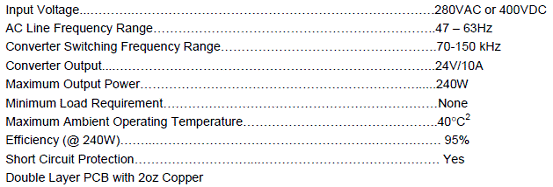
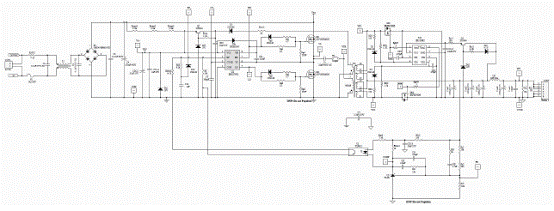
图4.IRS27951评估板电路图 IRS27951评估板材料清单: 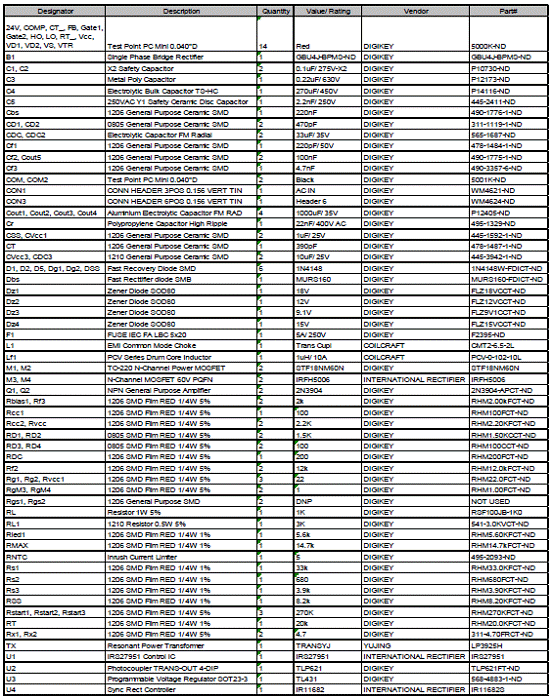
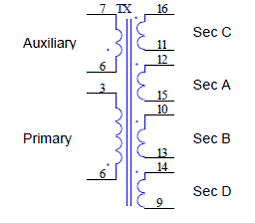
图5.IRS27951评估板变压器电路图 
图6.IRS27951评估板PCB布局图(顶层) 详情请见:  irac27951sr-240w[1].pdf
(889.63 KB)
irac27951sr-240w[1].pdf
(889.63 KB)
|







网友评论